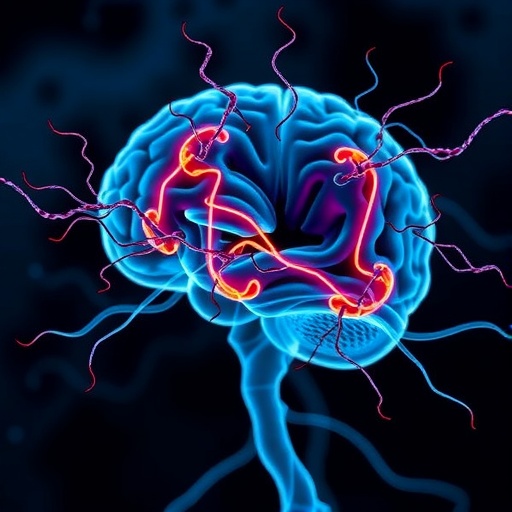
In the intricate landscape of neuronal biology, the epigenetic modifications of DNA play crucial yet often enigmatic roles. Recent research has thrown new light on one such facet: the impact of cytosine methylation and its oxidized derivatives, particularly 5-hydroxymethylcytosine, prevalent in postmitotic neurons. Despite their abundance, the functional significance of these epigenetic markers within neurons has remained elusive, leaving gaps in our understanding of neuronal regulation and vulnerability. A groundbreaking study now elucidates how these modifications intersect with DNA damage pathways, revealing a mechanistic basis for the neurotoxicity of certain chemotherapeutic agents, most notably cytarabine.
Central to this discovery is the process of active DNA demethylation mediated by TET enzymes, which oxidize 5-methylcytosine into a series of intermediates including 5-hydroxymethylcytosine. This epigenetic reprogramming is followed by base excision repair (BER) mechanisms, where the DNA glycosylase TDG excises the modified bases to restore unmodified cytosine. However, this precise repair process becomes a double-edged sword in the presence of specific cytidine analogues. Cytarabine, a widely used antineoplastic agent, disrupts this repair pathway by interfering with TDG’s function, which in turn leads to the accumulation of DNA double-strand breaks (DSBs) during the demethylation cycle. These breaks pose a serious threat to genomic stability, especially in neurons that are non-dividing and highly sensitive to DNA damage.
Further investigation reveals that the DNA double-strand breaks caused by cytarabine are predominantly converted into more severe chromosomal aberrations such as deletions and translocations through the activity of DNA ligase 4. This ligase is known for its role in non-homologous end joining, an error-prone DSB repair pathway. The formation of these deleterious chromosomal alterations underscores a novel cytotoxic mechanism for cytarabine, connecting epigenetic regulation directly to genome integrity in neurons. This offers an important molecular explanation for the long-recognized, yet previously poorly understood, cerebellar neurotoxicity associated with this drug.
.adsslot_Dw4zBuxPX7{width:728px !important;height:90px !important;}
@media(max-width:1199px){ .adsslot_Dw4zBuxPX7{width:468px !important;height:60px !important;}
}
@media(max-width:767px){ .adsslot_Dw4zBuxPX7{width:320px !important;height:50px !important;}
}
ADVERTISEMENT
Intriguingly, the neurotoxic effects of cytarabine are not uniform across all neuronal types. In vivo studies have pinpointed Purkinje cells and Golgi neurons within the cerebellum as the primary populations exhibiting elevated DNA damage upon cytarabine exposure. These specialized neurons endure a disproportionate burden of DNA lesions, implicating a unique vulnerability linked to their epigenetic landscape and gene expression profiles. Purkinje cells, in particular, show TET enzyme activity targeted to gene bodies characterized by enhancer-associated histone modifications—epigenetic signatures indicative of active transcription. Many of these genes orchestrate the delicate coordination of movement and motor control, elucidating how cytarabine’s genotoxic stress translates into cerebellar dysfunction and motor deficits.
Another striking facet of this research lies in the differential neurotoxic profiles among various cytidine analogues. While cytarabine induces predominantly double-strand DNA breaks leading to harmful chromosomal mutations, other analogues such as gemcitabine appear to cause mainly single-strand breaks. These less severe lesions are efficiently repaired by DNA ligase 3-mediated pathways, attenuating their toxicity. This divergence not only challenges the traditional view of cytidine analogues as a homogenous group in terms of side effects but also opens avenues for designing safer chemotherapeutics with minimized central nervous system complications.
The elucidation of the interplay between TET-mediated DNA demethylation and base excision repair processes in neurons represents a significant advancement in neuroepigenetics. It establishes a clear mechanistic link connecting DNA methylation dynamics to genomic stability and neuronal health. Such insights could redefine therapeutic strategies, allowing clinicians to weigh the neurotoxic risks of cytidine-based chemotherapies more precisely and tailor treatments accordingly.
Moreover, this research sheds light on the broader theme of neuronal epigenetic regulation and its implications for neurodegeneration and neurotoxicity. Postmitotic neurons rely heavily on robust DNA maintenance mechanisms since their capacity for regeneration is limited. Disruptions in the delicate balance of epigenetic marks and DNA repair not only jeopardize neuronal function but could also underpin the molecular pathology of various neurological disorders where DNA damage accumulates progressively.
From a translational perspective, the findings offer a rational basis for the previously observed selective cerebellar toxicity of cytarabine. By mapping the DNA damage to specific neuronal subtypes and gene regulation contexts, the study provides a blueprint to predict and potentially mitigate adverse neurological outcomes. This could lead to adjunct therapies aimed at preserving DNA repair fidelity or modulating TET enzyme activity during chemotherapy regimens.
At the molecular level, the work emphasizes the centrality of TDG and DNA ligases in safeguarding neuronal genomic integrity during active DNA demethylation. Their roles extend beyond canonical DNA repair, influencing how epigenetic information is rewritten and sustained over the lifespan of neurons. Targeting these enzymes pharmacologically may present novel opportunities to protect the brain from both endogenous and exogenous insults.
In sum, this research redefines our understanding of how chemical modifications of cytosine converge with DNA repair mechanisms to maintain neuronal function or, conversely, precipitate neurodegeneration. It highlights the unique vulnerability of the cerebellum, particularly Purkinje and Golgi cells, to cytarabine-induced DNA damage, tying molecular epigenetics to clinical neurotoxicity. This discovery has the potential to impact drug development, clinical oncology, and neurobiology, marking a milestone in dissecting the molecular intricacies of neuron-specific DNA metabolism.
The implications extend beyond oncology, touching on fundamental questions of how neurons manage and interpret epigenetic signals, and what happens when this delicate balance is disrupted. As the field continues to explore the intersections of epigenetics, DNA repair, and neurobiology, studies like this pave the way for breakthroughs in treating neurotoxic side effects and perhaps even neurodegenerative diseases linked to epigenetic dysregulation.
With the growing spotlight on TET enzymes and base excision repair pathways in neurons, this work urges a careful reconsideration of pharmacological approaches involving nucleoside analogues. It underscores the pressing need for careful mechanistic studies to foresee and circumvent unintended neuronal damage, ultimately striving for therapies that cure without compromising the brain’s intricate genetic and epigenetic architecture.
Subject of Research: Epigenetic DNA modifications and the molecular mechanisms underlying cytarabine-induced neurotoxicity in neurons.
Article Title: Mechanism of cytarabine-induced neurotoxicity
Article References:
Liu, JC., Wang, D., Callen, E. et al. Mechanism of cytarabine-induced neurotoxicity. Nature (2025). https://doi.org/10.1038/s41586-025-09210-9
Image Credits: AI Generated
Tags: 5-hydroxymethylcytosine significancebase excision repair mechanismschemotherapeutic agents and neurotoxicityCytarabine neurotoxicitycytidine analogues and DNA repairDNA double-strand breaks accumulationDNA glycosylase TDG functionDNA methylation in neuronsepigenetic modifications and neuronal regulationgenomic stability in neuronal cellsimpact of epigenetics on neuronal healthTET enzymes and DNA demethylation


